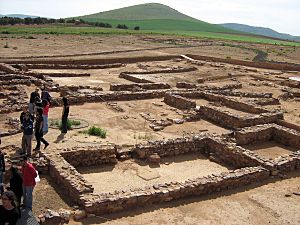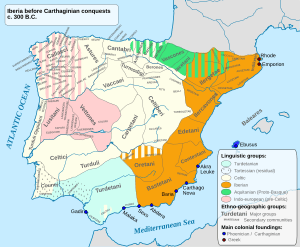Oretani facts for kids
The Oretani were an ancient people who lived in the Iberian Peninsula (modern-day Spain and Portugal) a long time ago, before the Roman Empire took over. They lived in what is now northeastern Andalusia, near the Guadalquivir river, and in parts of Sierra Morena and La Mancha. They were one of the many groups of people known as Iberians.
Contents
Who Were the Oretani?
Historians are not completely sure about the exact origins of the Oretani. They might have been an Iberian tribe, a Celtic tribe, or a mix of both. This would make them similar to the Celtiberians, who were also a blend of Celtic and Iberian cultures.
Some other groups, like the Mantesani and the Germani, lived nearby. Sometimes, people think these groups were part of the Oretani, but it's not fully confirmed.
Where Did the Oretani Live?

The Oretani lived in a region called Oretania. This area was mainly in the eastern Sierra Morena mountains. It covered most of what is now the province of Ciudad Real, the northern part of the province of Jaén, and the western half of the province of Albacete.
An ancient Roman writer named Pliny the Elder mentioned 14 cities in Oretania. Some of these cities might have been Tuia (possibly Toya) and Castulo (which was likely their main city, near modern-day Cazlona). Another historian, Diodorus Siculus, listed 12 towns.
Other important towns in their territory included Libissosa (perhaps Lezuza) and Baecula (Bailén, Jaén).
Oretani Culture

Historians also debate what language the Oretani spoke. Some believe they spoke an Iberian language, while others think they spoke a Celtic language, similar to the Celtiberians. This idea comes from the fact that some northern Oretani were also called Germani and Mantesani.
Many important archaeological sites have been found in the Oretanian area. These sites help us learn about their daily lives and culture. Some of these places include Linares, La Carolina, Montiel, Valdepeñas, Almagro, Oreto and Zuqueca, and Cerro de las Cabezas.
Oretani History
The Oretani people managed to stay independent for a long time, until the late 3rd century BC. At that time, their powerful leader, King Orison, was defeated in a battle in 228 BC.
After this defeat, King Orison decided to make an alliance with Carthage, a powerful empire from North Africa. This decision caused problems with their allies, the Germani, who wanted to keep fighting against Carthage. The Germani were eventually defeated by the famous Carthaginian general Hannibal in 221 BC. Some Oretani soldiers were even sent to Africa to fight in the Second Punic War.
Becoming Part of the Roman Empire
Over time, the Oretani and the Germani began to have a more friendly relationship with Rome. In 156 BC, both groups became part of the Roman province of Hispania Citerior. Even though they were now under Roman rule, they kept many of their own traditions and their Iberian culture for several more centuries. This process of adopting Roman ways is called "Romanization."
See also
 In Spanish: Oretanos para niños
In Spanish: Oretanos para niños
- Biche of Balazote
- Germani (Oretania)
- Pre-Roman peoples of the Iberian Peninsula


